Research on Autonomous Retail Vehicles: Lower Costs Accelerate Mass Production with Ever-spreading Retail Scenarios
Autonomous retail vehicles integrate technologies such as 5G, artificial intelligence, big data, mobile Internet and autonomous driving. They can move with the changes in the surrounding traffic autonomously. Users can hail such vehicles directly through APPs, and then they will arrive at the designated location accurately to provide convenient services.
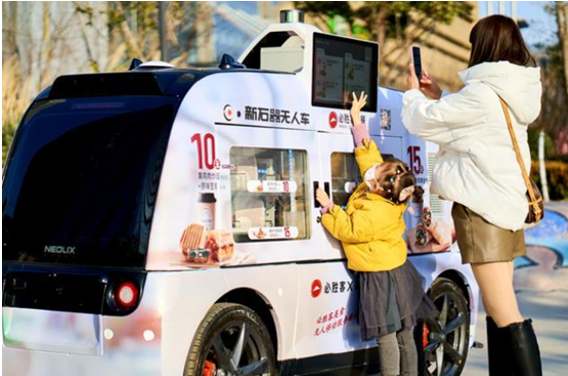
At present, the digital economy has become the key engine of China's economic development. According to information from the Ministry of Industry and Information Technology, China has built 1.615 million 5G base stations so far, serving more than 400 million 5G users. China is a global leader in 5G infrastructure, mobile Internet ecology, and e-commerce. Smartphones have become the preferred terminals of the digital economy, smart cars will become the second-ranking terminals, and autonomous retail vehicles act as not only important terminals connecting e-commerce services and smartphones, but also core intelligent terminals that realize the transition from "people looking for services" to "services looking for people" (or "goods looking for people").
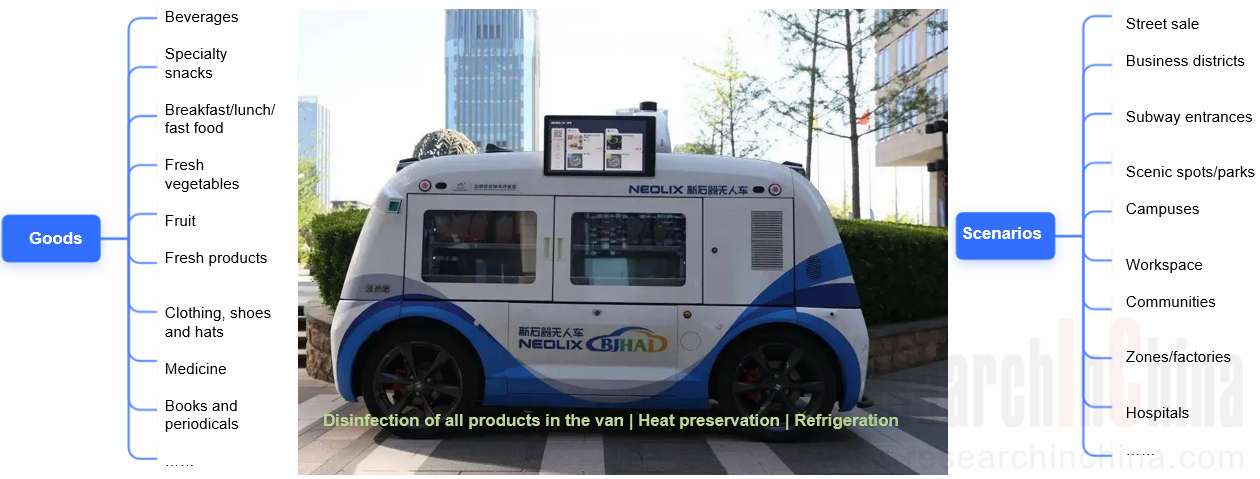
Autonomous retail vehicles are widely used in smart scenic spots, AI parks, commercial streets, zones, squares and other places for selling high-demand products such as beverages, breakfast, fast food, fresh products, and even shoes. Mobile new retail lets goods look for people. Users can stop autonomous vending vehicles by scanning QR codes, beckoning, and touching displays, and pay for what they choose by QR code scanning. This mode is time-saving, convenient and easy. For merchants, presenting products in front of customers in crowded areas (subway entrances, business districts, zones, etc.) during rush hours and lunch break when the demand hits the maximum can significantly increase the transaction volume. The service radius of merchants has been expanded from 1-2 kilometers to 5 kilometers.
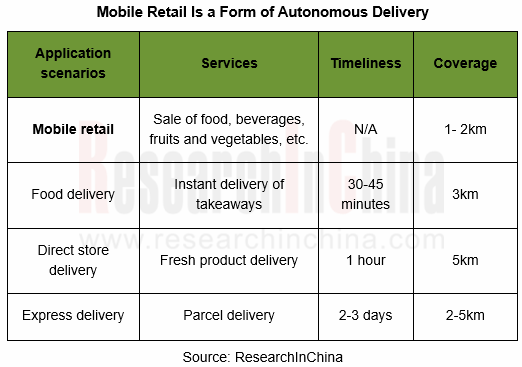
1. The policies for low-speed autonomous vehicles have been gradually improved
As low-speed autonomous vehicles, autonomous retail vehicles are used in cargo-carrying scenarios that are easier to handle. On May 25, 2021, Beijing High-level Autonomous Driving Demonstration Zone released the "Implementation Rules for the Management of Autonomous Delivery Vehicles", and issued vehicle numbers for autonomous delivery vehicles of JD.com, Meituan and Neolix. Since then, L4 autonomous driving technology has been verified by large-scale testing and on-road operation, which has promoted the vigorous development of China’s autonomous delivery industry.
Neolix launched nearly 1,000 autonomous vehicles in 2021, and plans to roll out another 2,000 autonomous delivery vehicles in 2022. Meituan plans to deploy 1,000 autonomous delivery vehicles in Shunyi District within three years, and put a total of 10,000 such vehicles into operation nationwide to achieve multi-city, multi-scenario and all-weather coverage.
Up to now, Beijing High-level Autonomous Driving Demonstration Zone has granted a total of 225 test licenses, including 86 body codes for autonomous delivery vehicles. So far, the demonstration zone has started the third phase of the construction project. In the demonstration zone, 332 digital intelligent intersections have been fully covered by the infrastructure within a range of 60 square kilometers. Scenarios such as autonomous retail, autonomous police patrols, and micro-circulation shuttling have approached citizens.
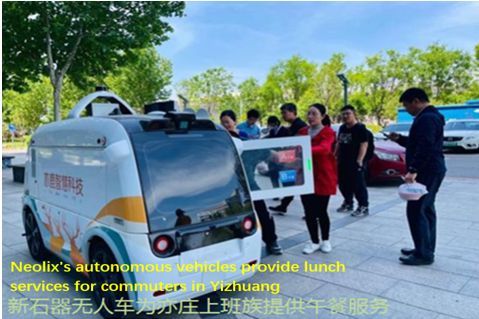

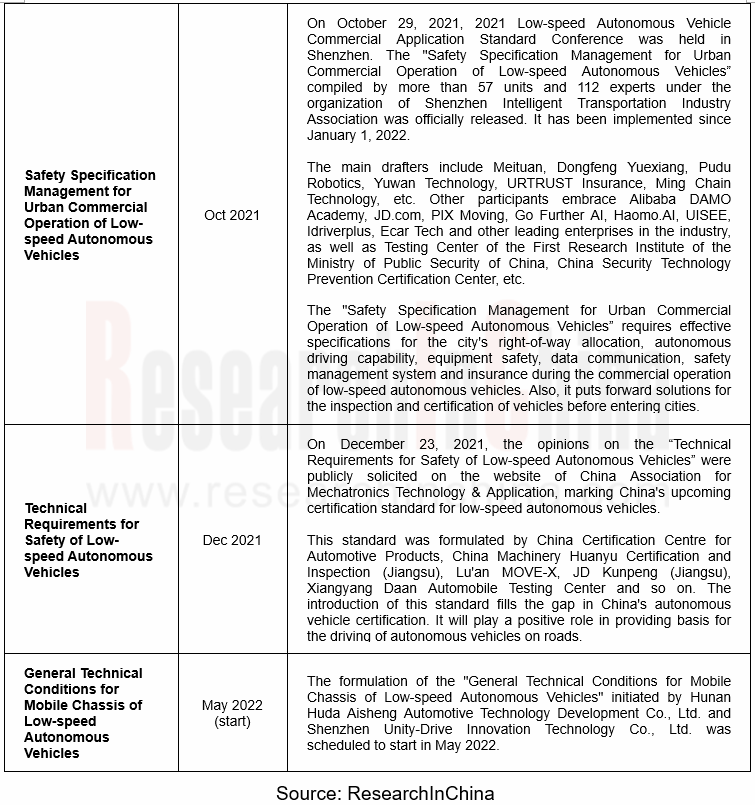
At the beginning of March 2022, Shanghai Municipal Transportation Commission announced that a total of 13 solutions for Shanghai Intelligent Connected Vehicle Demonstration Application Innovation Project had been confirmed after companies' voluntary application, on-site evaluation and solution review according to the "Implementation Plan for the Expansion of Demonstration Application Scenarios of Intelligent Connected Vehicles in Shanghai (2021-2023)". Among them, 2 solutions were involved with "smart retail", requiring "no less than 20 smart retail vehicles” in operation.
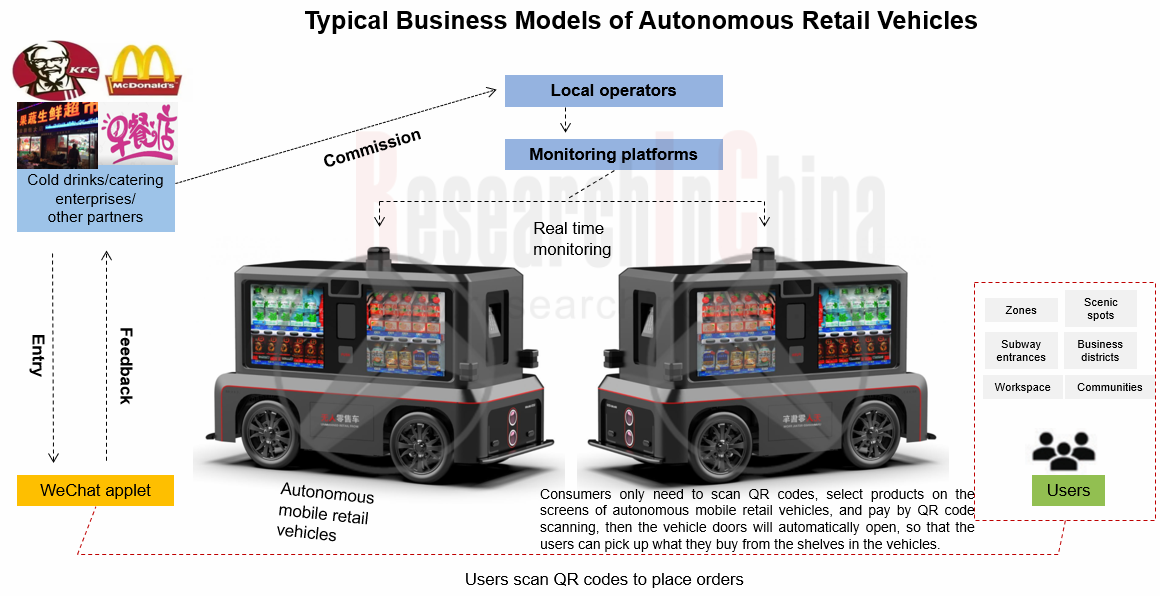
2. The costs of low-speed autonomous delivery vehicles are gradually sinking, promoting mass production of such vehicles for more scenarios
Depending on models, sensor solutions, etc., an autonomous delivery vehicle generally costs RMB200,000 ~ 500,000, let alone other expenses incurred by insurance, vehicle operation and maintenance, on-site safe operation and maintenance, remote monitoring, labor, cloud platform services, etc. China-based Haomo.AI has launched its first autonomous delivery vehicle, the Little Magic Camel, priced at RMB130,000. It is equipped with 3 mechanical LiDAR sensors worth about RMB40,000, radar, cameras and a computing platform. The total cost is nearly RMB100,000. Among the three basic systems of perception, decision-making and actuation, the computing platform plays a key role in the safe operation of autonomous retail vehicles.
With the gradual penetration of autonomous retail vehicles from fixed scenarios to more complex public road scenarios, extremely high requirements are placed on low-latency processing and multi-sensor information fusion of computing platforms. In the field of computing platforms, typical automotive chip enterprises include Horizon Robotics, Huawei, Idriverplus, Haomo.AI, Neolix, WeDrive.Al, Go Further AI, etc. The current mainstream computing platform is the NVIDIA Jetson AGX Xavier platform which is estimated at around RMB10,000 according to the supplier's price that is expected to further drop in the future.

In addition, LiDAR whose cost is on a downward trend plays an extremely critical role in the perception system. Most of the current autonomous delivery vehicles use 16-channel LiDAR. Under the stimulation of demand, Chinese LiDAR vendors, such as LeiShen Intelligent System, RoboSense, HESAI, Livox, Huawei, etc., have sprung up, and they can basically meet the demand of autonomous delivery vehicles.
Chassis-by-wire is one of three core components of an autonomous delivery vehicle. In China, main chassis-by-wire players include PIX, Teemo, UISEE, Skywilling, Neolix, and Haomo.AI. For example, PIX Moving offers chassis-by-wire at the price of RMB80,000 ~ 100,000. With the continuous deployment of autonomous delivery vehicles and autonomous retail vehicles in China, large-scale mass production will further drag down the price of chassis-by-wire.
?The chassis of autonomous vehicles is changeable, and a specific service function can be fixed horizontally like autonomous retail vehicles, autonomous media vehicles, etc.
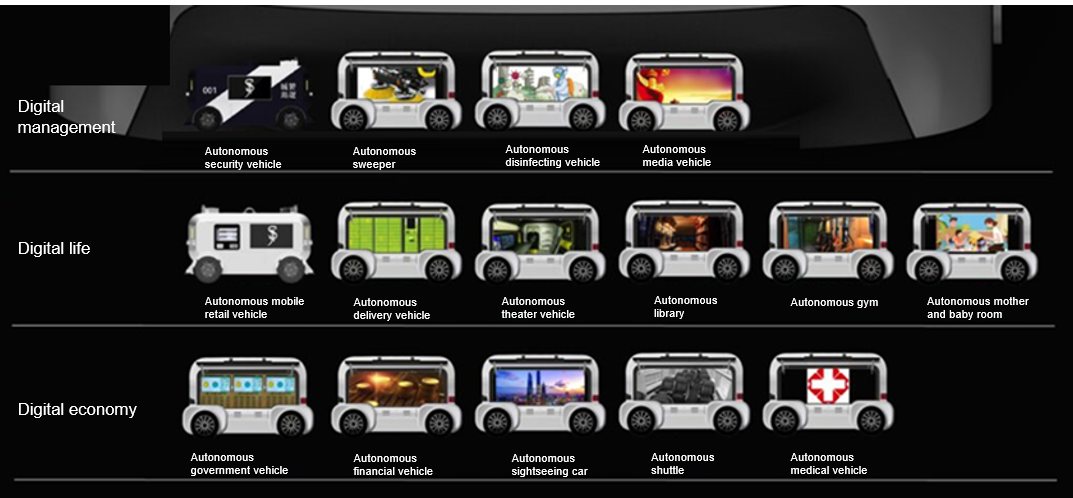
?UISEE’s autonomous vehicles: Different services can be performed at different times of the day with a higher operational efficiency.
UISEE, which is committed to all-scenario strategy, continues to expand application scenarios of its products. On September 25, 2021, it officially released UiBox (an L4 autonomous driving solution for urban services) and UiBox (an autonomous delivery vehicle) to further promote "commercial application of AI drivers" in all scenarios. UiBox can offer different services at different times to improve operational efficiency.

3. The application scenarios of autonomous retail vehicles have spread from semi-enclosed zones to open roads and then to large communities
In 2021, Jushi Technology deployed an autonomous fleet in Zhangjiang Artificial Intelligence Island in Shanghai where employees can buy a variety of food, office supplies, and daily necessities from autonomous retail vehicles. Autonomous delivery vehicles can provide food delivery services such as pizza delivery to restaurants on the artificial intelligence island. After employees place orders through their mobile phones, autonomous vehicles will automatically deliver the meals prepared by restaurants to employees who only need pick up the meals according to the notification on their mobile phones. In addition, the supporting monitoring platform can surveil the operation of autonomous vehicles around the clock to ensure safety.

On June 1, 2022, Shanghai WeDrive.Al officially introduced autonomous retail vehicles to Nanfeng Future Community, Shangyu, Shaoxing, Zhejiang to provide autonomous sales services for the community. Nanfeng Future Community consists of City Star, Liangjiang Home and Community Center Complex, which are home to more than 40,000 residents and more than 12,700 families.

On April 22, 2022, Neolix’s autonomous vehicles were also welcomed into the large community of Shanghai Lijing in Pudong District, Shanghai. Autonomous retail companies are covering more application scenarios.
4. OEMs use their advantages in technology and manufacturing to explore new businesses
On April 30, 2021, In-driving Tech was invited to participate in the Science Night of Han Street in Wuhan. The interactive area displayed the Sharing-Box, a high-tech autonomous smart car developed by In-driving Tech and Dongfeng Motor.
Sharing Box is an autonomous intelligent point-to-point transportation platform launched by Dongfeng Motor. It is constructed by integrating TITAN (an autonomous driving domain controller of In-driving Tech) and Athena Software to realize L4 autonomous driving based on HD maps in specific scenarios.
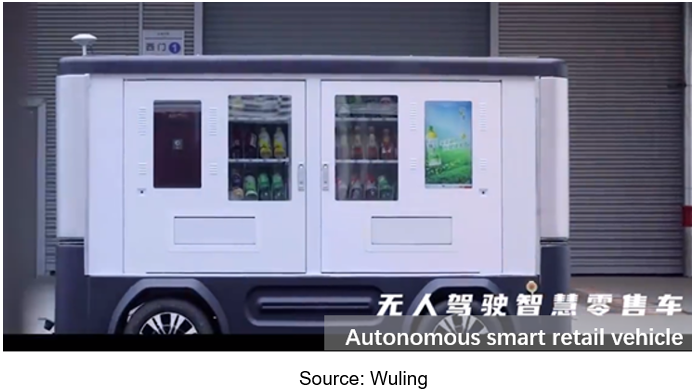
In addition to Dongfeng Motor, Wuling has also explored new businesses with its own technology and manufacturing advantages, and launched "Xiaoling" driverless smart retail vehicle, which has been practically applied.
In Baoding, Haomo.AI, a company backed up by Great Wall Motor, has built the world's first flexible manufacturing base for L4 low-speed autonomous vehicles. It produces a variety of models (including autonomous retail vehicles). After the latest upgrade, the design capacity of the production line can reach 10,000 vehicles per year.
5. With the support of capital, major players aggressively enhance resilience, use closed data loop to continuously improve technology and ensure safe operation


During the R&D process of Little Donkey, which can run more than 100 kilometers on a charge of 4 kWh, Alibaba DAMO Academy has built its own autonomous driving cloud platform from the very beginning, which uploads massive data (scenario databases, autonomous vehicle data, data from data collection vehicles) to Alibaba Cloud. Carrying out data management, simulation testing and algorithm model training on the cloud has greatly improved the R&D efficiency of autonomous driving algorithms. Based on this autonomous driving cloud platform, Alibaba DAMO Academy has launched the world's first "hybrid simulation test platform" for autonomous driving. The platform uses a combination of virtual and reality simulation technologies, introduces real road test scenarios and cloud trainers. It takes only 30 seconds to simulate an extreme scenario, and the system’s daily virtual test mileage can exceed 8 million kilometers, greatly improving the training efficiency of autonomous driving AI models.
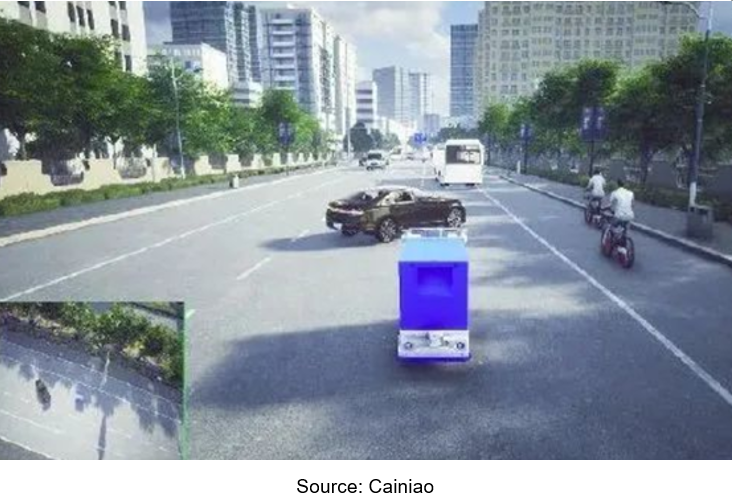
From its debut in September 2020 to March 31, 2022, Little Donkey delivered more than 10 million logistics orders.
According to Jie Jinghua, a partner of Neolix, the current commercial scenarios of Neolix’s autonomous vehicles include both open roads and closed zones such as campuses. A vehicle can obtain 100T data per day, and it actively captures about 20G/day of valuable data (including the original point cloud of LiDAR, images, intermediate results, logs and so on). The Ocean data system completes the storage, cleaning, labeling and model training of these data before finally forming a closed data loop.
When autonomous vehicles become more sophisticated, the ultimate challenge no longer lies in underlying architectures or technical problems, but fragmented scenarios, special extreme situations and human behaviors that can never be predicted instead which account for 5%.
China Automotive Lighting and Ambient Lighting System Research Report, 2025
Automotive Lighting System Research: In 2025H1, Autonomous Driving System (ADS) Marker Lamps Saw an 11-Fold Year-on-Year Growth and the Installation Rate of Automotive LED Lighting Approached 90...
Ecological Domain and Automotive Hardware Expansion Research Report, 2025
ResearchInChina has released the Ecological Domain and Automotive Hardware Expansion Research Report, 2025, which delves into the application of various automotive extended hardware, supplier ecologic...
Automotive Seating Innovation Technology Trend Research Report, 2025
Automotive Seating Research: With Popularization of Comfort Functions, How to Properly "Stack Functions" for Seating?
This report studies the status quo of seating technologies and functions in aspe...
Research Report on Chinese Suppliers’ Overseas Layout of Intelligent Driving, 2025
Research on Overseas Layout of Intelligent Driving: There Are Multiple Challenges in Overseas Layout, and Light-Asset Cooperation with Foreign Suppliers Emerges as the Optimal Solution at Present
20...
High-Voltage Power Supply in New Energy Vehicle (BMS, BDU, Relay, Integrated Battery Box) Research Report, 2025
The high-voltage power supply system is a core component of new energy vehicles. The battery pack serves as the central energy source, with the capacity of power battery affecting the vehicle's range,...
Automotive Radio Frequency System-on-Chip (RF SoC) and Module Research Report, 2025
Automotive RF SoC Research: The Pace of Introducing "Nerve Endings" such as UWB, NTN Satellite Communication, NearLink, and WIFI into Intelligent Vehicles Quickens
RF SoC (Radio Frequency Syst...
Automotive Power Management ICs and Signal Chain Chips Industry Research Report, 2025
Analog chips are used to process continuous analog signals from the natural world, such as light, sound, electricity/magnetism, position/speed/acceleration, and temperature. They are mainly composed o...
Global and China Electronic Rearview Mirror Industry Report, 2025
Based on the installation location, electronic rearview mirrors can be divided into electronic interior rearview mirrors (i.e., streaming media rearview mirrors) and electronic exterior rearview mirro...
Intelligent Cockpit Tier 1 Supplier Research Report, 2025 (Chinese Companies)
Intelligent Cockpit Tier1 Suppliers Research: Emerging AI Cockpit Products Fuel Layout of Full-Scenario Cockpit Ecosystem
This report mainly analyzes the current layout, innovative products, and deve...
Next-generation Central and Zonal Communication Network Topology and Chip Industry Research Report, 2025
The automotive E/E architecture is evolving towards a "central computing + zonal control" architecture, where the central computing platform is responsible for high-computing-power tasks, and zonal co...
Vehicle-road-cloud Integration and C-V2X Industry Research Report, 2025
Vehicle-side C-V2X Application Scenarios: Transition from R16 to R17, Providing a Communication Base for High-level Autonomous Driving, with the C-V2X On-board Explosion Period Approaching
In 2024, t...
Intelligent Cockpit Patent Analysis Report, 2025
Patent Trend: Three Major Directions of Intelligent Cockpits in 2025
This report explores the development trends of cutting-edge intelligent cockpits from the perspective of patents. The research sco...
Smart Car Information Security (Cybersecurity and Data Security) Research Report, 2025
Research on Automotive Information Security: AI Fusion Intelligent Protection and Ecological Collaboration Ensure Cybersecurity and Data Security
At present, what are the security risks faced by inte...
New Energy Vehicle 800-1000V High-Voltage Architecture and Supply Chain Research Report, 2025
Research on 800-1000V Architecture: to be installed in over 7 million vehicles in 2030, marking the arrival of the era of full-domain high voltage and megawatt supercharging.
In 2025, the 800-1000V h...
Foreign Tier 1 ADAS Suppliers Industry Research Report 2025
Research on Overseas Tier 1 ADAS Suppliers: Three Paths for Foreign Enterprises to Transfer to NOA
Foreign Tier 1 ADAS suppliers are obviously lagging behind in the field of NOA.
In 2024, Aptiv (2.6...
VLA Large Model Applications in Automotive and Robotics Research Report, 2025
ResearchInChina releases "VLA Large Model Applications in Automotive and Robotics Research Report, 2025": The report summarizes and analyzes the technical origin, development stages, application cases...
OEMs’ Next-generation In-vehicle Infotainment (IVI) System Trends Report, 2025
ResearchInChina releases the "OEMs’ Next-generation In-vehicle Infotainment (IVI) System Trends Report, 2025", which sorts out iterative development context of mainstream automakers in terms of infota...
Autonomous Driving SoC Research Report, 2025
High-level intelligent driving penetration continues to increase, with large-scale upgrading of intelligent driving SoC in 2025
In 2024, the total sales volume of domestic passenger cars in China was...